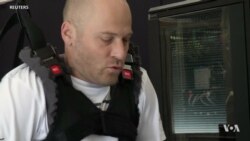ຜູ້ຊາຍອຳມະພາດຄົນນຶ່ງ ທີ່ທ່ານກຳລັງຈະຮູ້ຈັກນີ້ ບໍ່ໄດ້ມີຄວາມຫວັງເລີຍ ວ່າມື້ນຶ່ງ
ລາວຈະສາມາດກັບຄືນມາຍ່າງໄດ້ອີກ. ແຕ່ຍ້ອນອຸປະກອນການແພດຊະນິດໃໝ່ນີ້,
ສິ່ງຕ່າງໆແມ່ນກຳລັງດີຂຶ້ນສຳລັບລາວ. ນັກຂ່າວວີໂອເອ ມາຣຽມມາ ດີອາລໂລ ມີ
ລາຍງານເພີ່ມເຕີມ.
ທ້າວ ເຊບັສຕຽນ ທອບເບຼີ ໄດ້ເປັນອຳມະພາດຕັ້ງແຕ່ແອວລົງໄປຫຼັງຈາກໄດ້ປະສົບອຸ
ບັດຕິເຫດທາງລົດຖີບ ເມື່ອຫ້າປີທີ່ຜ່ານມາ. ປີກາຍນີ້ ລາວໄດ້ເຮັດຂັ້ນຕອນການວິໄຈ
ເຊິ່ງສິ່ງກະຕຸ້ນກະດູກສັນຫຼັງໄດ້ຖືກວສອດໃສ່ໃນຮ່າງກາຍຂອງລາວ.
ທ່ານ ເກຣັກກໍ ກວກທີນ, ຈາກສະຖາບັນເທັກໂນໂລຈີ ໂລຊານ ຂອງລັດຖະບານກາງ
ສວິດເຊີແລນ ກ່າວວ່າ “ດ້ວຍການຝຶກຊ້ອມໜ້ອຍນຶ່ງ ລາວຈະສາມາດທີ່ຈະກະຕຸ້ນ,
ຕົວຢ່າງ, ການຢຽດຂາຂອງລາວ. ສະນັ້ນທ່ານຈຶ່ງເຫັນວ່າລາວຈະກຳລັງພັບຂາຊ້າຍ
ຂອງລາວໄດ້, ລາວສາມາດທີ່ຈະຢຽດມັນໄດ້ເຕັມທີ່ ຂາຊ້າຍຂອງລາວ ຈະຕ້ານທິດ
ທາງຂອງແຮງດຶງດູດ ແລະ ຮັກສາການຢຽດໄວ້ໄດ້.”
ແຕ່ເບິ່ງວ່າຄືຈະເຈັບປວດດັ່ງທີ່ເຫັນນັ້ນ, ທ່ານ ທອບເບຼີ ອາຍຸ 47 ປີ ບໍ່ພຽງແຕ່ຮູ້ສຶກ
ເປັນບຸນຄຸນເທົ່ານັ້ນ ແຕ່ລາວຍັງມີຄວາມຫວັງສຳລັບອະນາຄົດຂອງລາວດ້ວຍ.
ທ່ານ ເຊບັສຕຽນ ທອບເບຼີ, ຄົນເຈັບຜູ້ນັ້ນກ່າວວ່າ “ຂ້າພະເຈົ້າຮູ້ສຶກວ່າ, ນຶ່ງປີຫຼັງຈາກ
ນັ້ນມາ, ຂ້າພະເຈົ້າໄດ້ມີຄວາມກ້າວໜ້າ ໃນການເຄື່ອນໄຫວບາງຢ່າງ. ຂ້າພະເຈົ້າພຽງ
ແຕ່ຫວັງວ່າ ມື້ຕໍ່ໄປ ມັນຈະເກີດຫຍັງຂຶ້ນກັບຂ້າພະເຈົ້າ, ປີຕໍ່ໄປ, 10 ປີຫຼັງຈາກນັ້ນ.
ຂ້າພະເຈົ້າຈະໄດ້ເຫັນຫຍັງຢູ່ໃນໂຕຂອງຂ້າພະເຈົ້າ. ຈະມີໃຜຮູ້?
ໃນລະຫວ່າງການບຳບັດຢູ່ໂຮງໝໍຂອງມະຫາວິທະຍາໄລ ໂລຊານ ໃນປະເທດ ສວິດ
ເຊີແລນ ນັ້ນ, ທ່ານ ທອບເບຼີ ໄດ້ເຮັດວຽກກັບນັກກາຍະບຳບັດ. ລາວໄດ້ໃຊ້ໄມ້ຄ້ຳ
ເພື່ອຍ່າງຂຶ້ນຍ່າງລົງໃນຫ້ອງປິ່ນປົວ.
ທ່ານ ເກຣັກກວາ ຄົວທີນ ກ່າວວ່າ “ນີ້ແມ່ນສິ່ງທີ່ເຮົາເອີ້ນວ່າ ເຄື່ອງຜະລິດຊີບພະຈອນ
ທີ່ສາມາດປ່ຽນຖ່າຍໄດ້, ເສັ້ນລວດໄຟຟ້າເສັ້ນນີ້ ແມ່ນຈະຖືກສອດໃສ່ລະຫວ່າງ ກະ
ດູກ ກັບ ເສັ້ນປະສາດໄຂສັນຫຼັງ ຢູ່ສ່ວນທີ່ຕ່ຳຂອງມັນ ເພື່ອກະຕຸ້ນພື້ນທີ່ຂອງເສັ້ນປະ
ສາດໄຂສັນຫຼັງ ທີ່ປົກກະຕິຈະຄວບຄຸມການເຄື່ອນໄຫວຕ່າງໆຂອງຂາ.”
ຄົນອຳມະພາດສາມຄົນ ລວມທັງທ່ານ ເດວິດ ມາເຊ ປັດຈຸບັນນີ້ ແມ່ນໄດ້ຮັບການປູກ
ຖ່າຍດັ່ງກ່າວນັ້ນ. ທ່ານ ມາເຊ ກ່າວວ່າ ມັນບໍ່ຄືກັບການປິ່ນປົວອື່ນໆ ທີ່ລາວເຄີຍໄດ້
ເຮັດມາກ່ອນ.
ທ່ານ ເດວິດ ມາເຊ ກ່າວວ່າ “ມັນຄືກັບແລ່ນມາຣາທອນ ກັບ ຖືໄຂ່ໄວ້ກັບມືແທ້ໆ ແລະ
ເຈົ້າຈະພະຍາຍາມຢ່າບີບມັນ ແລະ ໃນເວລາດຽວກັນ ເຈົ້າກໍຈະດັນໃຫ້ແຮງເທົ່າທີ່ເຈົ້າ
ສາມາດເຮັດໄດ້.”
ການບາດເຈັບຢູ່ເສັ້ນປະສາດໄຂສັນຫຼັງມີໄດ້ຫຼາຍຮູບແບບ. ທ່ານນາງ ໂຈສລິນ
ບລັອດຈ໌, ນັກສັນຍະແພດໂຣກເສັ້ນປະສາດ ຢູ່ໂຮງໝໍມະຫາວິທະຍາໄລ ໂລຊານ ຜູ້
ທີ່ໄດ້ປູກຖ່າຍອຸປະກອນຕ່າງໆ ສຳລັບຄົນປ່ວຍແຕ່ລະຄົນກ່າວວ່າ ການປິ່ນປົວແບບນີ້
ຈະບໍ່ໄດ້ຜົນກັບຜູ້ທີ່ມີອາການບາດເຈັບສາຫັດ.
ທ່ານນາງ ໂຈສລິນ ບລັອດຈ໌ ກ່າວວ່າ “ມັນສຳຄັນຫຼາຍ ທີ່ຈະມີສ່ວນສຸດທ້າຍຂອງເສັ້ນ
ປະສາດໄຂສັນຫຼັງຖືກປົກປ້ອງໄວ້ ຍ້ອນວ່າ ນັ້ນແມ່ນບ່ອນທີ່ພວກເຮົາຈະປູກຖ່າຍ
ເສັ້ນລວດໄຟຟ້າໃສ່. ແລະ ຖ້າພາກສ່ວນນີ້ ໄດ້ຮັບບາດເຈັບ ມັນຈະຍາກຫຼາຍ ທີ່ຈະ
ເດົາໄດ້ວ່າ ແມ່ນຫຍັງກຳລັງເກີດຂຶ້ນກັບເຄື່ອງກະຕຸ້ນ.”
ຜົນຂອງການຄົ້ນຄວ້າວິໄຈນີ້ ໄດ້ຖືກຕີພິມໃນວາລະສານ Nature Neuroscience
ໃນວັນພະຫັດທີ່ຜ່ານມາ.
A paralyzed man you're about to meet didn't have much hope that one day he'd be able to walk again. But thanks to a new medical device...things are looking up for him. VOA's Mariama Diallo reports.
Sebastian Tobler was paralyzed from the waist down after a bicycle accident five years ago. Last year he underwent an experimental procedure where a spinal cord stimulator was implanted in his body.
"With some training he's able to trigger, for example, a full leg extension of his leg. So you see he is doing a flexion of the left leg, he's able to extend completely his left leg against the direction of gravity and maintain the extension."
But as painful as it may seem, the 47 year-old Tobler is not only grateful but also hopeful of what the future may have in store for him.
"I feel that, one year after, I've progressed with some movement. I'm just looking forward to what it will bring me the next day, the next year, ten years afterwards; what will I see in my body // who knows?"
During a therapy session at Lausanne University Hospital in Switzerland, Tobler works with a physical therapist. He uses crutches to walk up and down a treatment room.
"This is what we call an implantable pulse generator // this electrode... is inserted between the bone and spinal cord at the low part of it to stimulate the region of the spinal cord that normally control leg movements."
Three paraplegics including David Mzee ((Ma-Zay)) have so far received the implant. Mzee says it's unlike any treatment he has ever received
"It's really like running a marathon and holding eggs in your hands and you're trying not to squeeze them and at the same time you're pushing as hard as you can."
Spinal cord injury can take many forms. Jocelyne Bloch, a neurosurgeon at Lausanne University Hospital who implanted the devices in each of the patients, says this treatment won't work for the most severe injuries.
"It's very important to have the last part of the spinal cord intact because that's where we are going to implant the electrodes. And if this is injured it's very hard to predict what is going to happen with the stimulation."
The results of this experimental research were published in the journal Nature Neuroscience on Thursday.





